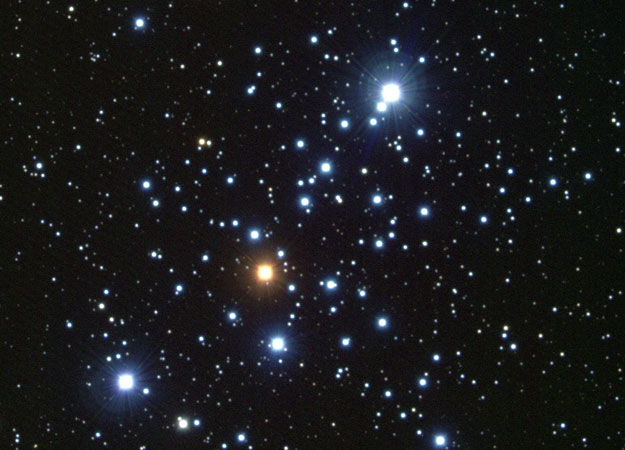
|
Explanation: Bright blue stars highlight the open cluster known as M103. The gas clouds from which these stars condensed has long dispersed. Of the stars that were formed, the brightest, bluest, and most massive have already used up their nuclear fuel and self-destructed in supernova explosions. A 20 million-year age for M103 was estimated by finding the brightest main-sequence stars that still survive and theoretically computing their lifetimes. In fact, a formerly blue star has recently evolved off the main sequence and is visible above as the red giant star near the cluster center. In general, yellow stars like our Sun are usually less bright and hence less prominent in open clusters than their massive blue cousins. Light takes about 14 light-years to cross M103. Although visible with binoculars toward the constellation of Cassiopeia, M103's great distance of 8000 light years makes it appear four times smaller than a full moon.
|
January February March April May June July August September October November December |
| ||||||||||||||||||||||||||||||||||||||||||||||||
NASA Web Site Statements, Warnings, and Disclaimers
NASA Official: Jay Norris. Specific rights apply.
A service of: LHEA at NASA / GSFC
& Michigan Tech. U.
Based on Astronomy Picture
Of the Day
Publications with keywords: open cluster - M 103
Publications with words: open cluster - M 103
See also:
- APOD: 2025 August 7 B The Double Cluster in Perseus
- APOD: 2025 April 28 B Gum 37 and the Southern Tadpoles
- Open Star Clusters M35 and NGC 2158
- APOD: 2025 February 25 B M41: The Little Beehive Star Cluster
- APOD: 2025 February 11 B The Spider and the Fly
- APOD: 2024 October 29 B NGC 602: Stars Versus Pillars from Webb
- NGC 7789: Caroline s Rose
